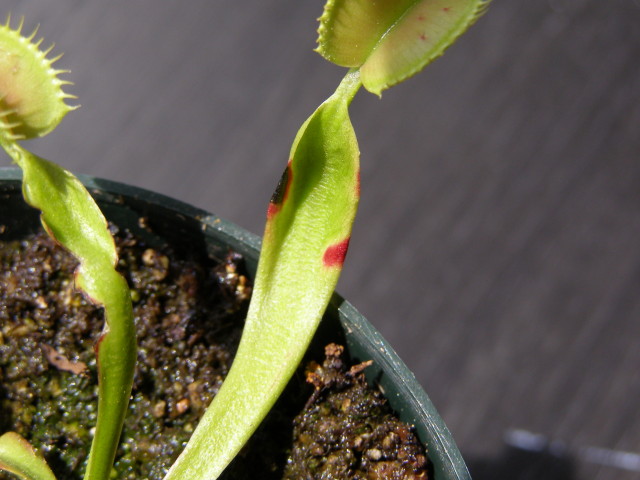Question Red spots and what loo
Red spots and what loo
QUESTION: I am wondering if you can tell me what these spots are from
on the three venus flytraps I bought from Cooks, They are on
a pestioles,paradisia and fang. They started out tiny,
barely noticable and then got gradually larger and
eventually turn black. In this picture, one leaf looks like
it is being eaten on the same plant. I live in Seattle, Wa.
and keep them in the windowsill, my other 5 flytraps coming
out of dormancy have noting like this. What is it and what
can I do to fix it......Thanks, Scott Clark
ANSWER: Hi Scott,
On the left leaf you definitely have a pest taking bites out of it. Slugs or snails would be my first guess. The red spots look like a pest of some kind may be present. Take a hand-lense and inspect the plant. Try to make sure you don't have thrips, spider mites, or scale present. Those types of insects can cause damage, and introduce fungus which will cause the red spots. If you see bugs, spray with a Neem product. Be sure to follow the directions on the package. For the slug you may just have to look around and see if you have one hiding somewhere. I had some mystery damage on some Mexican butterworts one time and discovered that some slug eggs had hatched in some soil. It's the babies that do the most damage.
Good Growing!
Jeff Dallas
Sarracenia Northwest
http://www.cobraplant.com
---------- FOLLOW-UP ----------
QUESTION: So how do you get rid of the snails or slugs, I have looked all over in the soil and everything and can't find anything. Someone said to wait till dark and then look. Is this correct. The person who I bought them from has agreed to replace them if I send these back, and I am seriously considering that, unless it is an easy fix, plus I don't want anything to spread to all my healthy plants. Thank you............Scott Clark
ANSWER: Hi Scott,
Sorry for taking a bit to get back to you.
You can put a little bait around your plant. I've put just a drop of two of Deadline on a stick or other item and set in near the plant. You could also set out a beer trap.
The red spots and possible pest are harder to determine. If the plant arrived looking sad, then sending them back may not be a bad option. Did you inspect the plants for any insect pests?
Good Growing!
Jeff Dallas
Sarracenia Northwest
http://www.cobraplant.com
---------- FOLLOW-UP ----------
QUESTION: Thanks for your answer. I have another question, I have three neps, n. ventrata,n. ramispina and n. ventricosa(very small), and I am wondering just how much direct sunlight they actually need, I have seen on other sites people saying 4 hours per day. I live in Seattle and have east and south windowsills, but I usually just give them bright light. Also, I am looking to get 2 or 3 more neps, and want some nice looking or not very popular species if possible. Could you please give me three nep. species besides what I have that I could get that would do well. I get sun all day, when sunny, and the temps on warm days are 75-85 degrees with humidity being between 45 and 65(avg is 50-around 62) depending on how many windows I have open. I really appreciate your help,thanks.....Scott Clark
AnswerHi Scott,
The four hour number is a good ballpark figure. I find it varies some by species. I have four plants in a south window in my living room that get around 3 hours of sun, and bright indirect light the rest of the day. They are a N. x deRooses' alata, N. x caesar, and a N. maxima hybrid (Poi Dog) in the south window. All have nice pitchers they grew in that window over the spring. In a west window I have N. truncata X thorelli. It also pitchers nicely, but gets more sun. Some species such as N. truncata definitely are more shade tolerant.
For good species to add to your collection good choices would be: N. truncata, N. maxima hybrids such as N. x miranda (This one gets very big.), the Dark (Blood Red) N. sanguinea, N. sibuyanensis, N. gymnaphora, N. copelandii, N. burkeii to name a few. All of these have been very good growers.
Good Growing!
Jeff Dallas
Sarracenia Northwest
http://www.cobraplant.com






